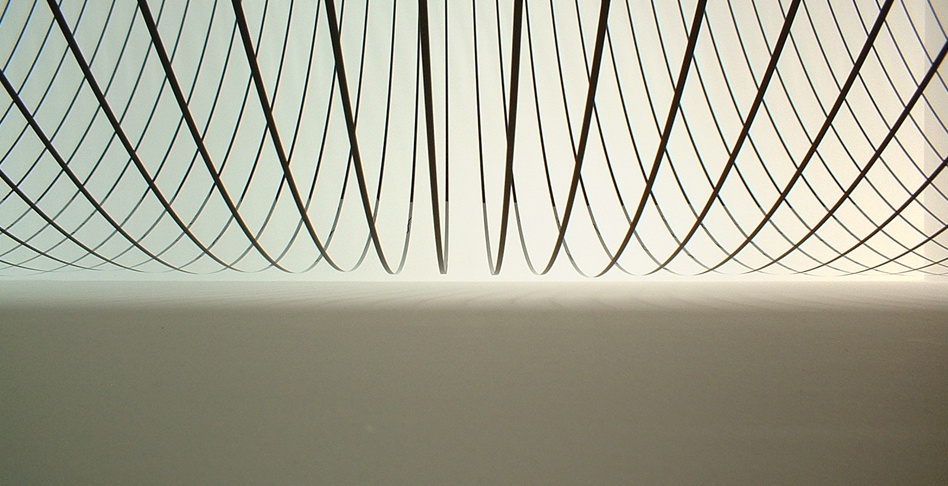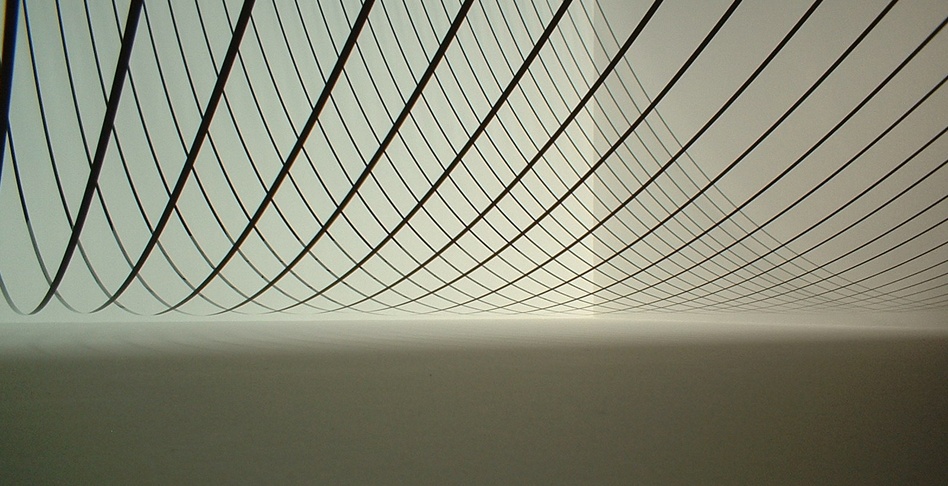The New York-based artist Zilvinas Kempinas has attained world-wide fame for
his large-scale installations and dynamic sculptures of magnetic tape. His
constructions take the form of ephemeral architectural elements, which may be
static or dynamic and volumetric or planar.
The project Still, created by the artist for the Garage Center, is an
installation consisting of countless strands of magnetic film. Hung around the
perimeter of the hall, they form a gigantic composition of parabolic
lines.
Kempinas’ art is intended to alter our sense of space and reveal the hidden
qualities of our familiar world. Placed in a particular environment, the
objects create unexpected visual effects that cause the space to begin to break
up, move, and vibrate. It appears capricious, suddenly taking on a clear shape,
then immediately losing it: upon gaining a structure, it disintegrates.
The primary categories of Kempinas’ art are volatility and ephemerality; words
which can also be used to describe our reality. The world today is seen by us
as fragmented and inconsistent, and the endless streams of information only
reinforce our sense of disorientation. In Kempinas’ works, the magnetic tape
does not convey anything specific, but immerses us in an atmosphere of visual
intensity and abstract contemplation; wherein the viewer is free to find his or
her own meaning and means of interpretation.
Kempinas’ work has much in common with the aesthetics of minimalism,
kineticism, and constructivism. In his works, the art of the past generates
unexpected connections with the present and takes on a new and topical meaning.
Still has a direct association with the legacy of constructivism
through the architecture of the Garage Center. Like Kempinas, the
constructivists were interested in creating a perfect spatial structure, the
possibilities of transforming an object, and the dynamics of audience
perception. However, unlike the work of his predecessors, Kempinas’ art is
devoid of functionalism and practicality. The artist does not simulate the
objective environment, but our new human experience, the value of which lies in
the unpredictability of an individual’s life course.
Artist biography
Zilvinas Kempinas was born in Plungė (Lithuania) in 1969 and has been living
and working in New York for more than 10 years. He graduated from the Vilnius
Art Academy, and later studied at Hunter College, New York. In 2009, he
represented Lithuania at the 53rd Venice Biennale and in 2007 he received the
prestigious Calder Prize and was the resident artist at Atelier Calder in
Saché, France in 2008. He has been widely exhibited in the United States and
internationally, including solo shows in Galeria Leme (Sao Paulo), Yvon Lambert
(New York), Spencer Brownstone Gallery (New York), Baltic Centre for
Contemporary Art (Gateshead, UK), Kunsthalle Wien (Vienna), Contemporary Art
Centre, Galerija Vartai (Vilnius), Palais de Tokyo (Paris), P.S.1 Contemporary
Art Centre (New York). Selected group exhibitions include: MoMA (New York);
53rd Venice Biennalle (Italy), 6th Liverpool Biennial (UK); Yvon Lambert
(Paris, New York); Lunds Konsthall (Lund, Sweden); Nam June Paik Art Center
(Yongin City, Korea), Transmediale 10, Manifesta 7 (Bolzano, Italy); SFMOMA
(San Francisco, USA); MUDAM (Luxembourg).
Curator of the exhibition:
Yulia Aksenova, curator of Garage Center for Contemporary Culture.
After graduating from Russian State University for the Humanities in 2002 she
worked at the Newest Trends Department of the State Tretyakov Gallery and
realized independent curatorial projects, such as special projects at First,
Second and Third Moscow Biennale.
In 2008 she completed her studies at Curatorial Training Programme, De Appel,
CCA, Amsterdam.
In 2009 started career at Garage Center for Contemporary Culture as the Head of
Educational Department.
In 2010 realized "Russian Utopias" project at Garage Center for Contemporary
Culture.


